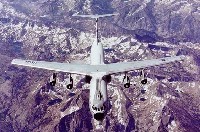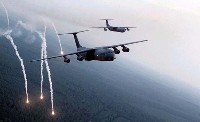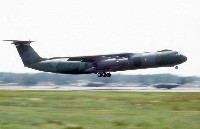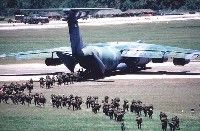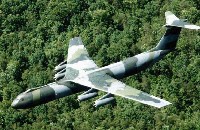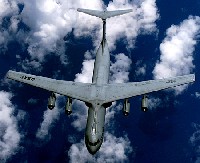|
Global Aircraft -- C-141 Starlifter
Aviation Center
US Attack
US Bombers
US Cargo
US Fighters
US Helicopters
US Patrol/Pursuit
US Reconnaissance
US Tankers
US Trainers
US UAV's
US X Planes
Orbiter Vehicles
WWI Aircraft
WWII Aircraft
Airbus
Antonov
Boeing
Dassault
Ilyushin
Kamov
MiG
Mil
Saab
Sukhoi
Tupolev
Yakovlev
Joint/Rest of World
Entertainment Center
Members Center
New Technologies
Contact Us
Extra Navigation
GAC Engine
C-141 Starlifter Specifications
C-141 Starlifter Achievements
C-141 Starlifter Features
The C-141B is a "stretched" C-141A with in-flight refueling capability. The stretching of the Starlifter consisted of lengthening the planes 23 feet 4 inches (7.11 meters). The added length increased the C-141 cargo capacity by about one-third, for an extra 2,171 cubic feet (62.03 cubic meters). The lengthening of the aircraft had the same overall effect as increasing the number of aircraft by 30 percent. The C-141A, built between 1963 and 1967, was AMC's first jet aircraft designed to meet military standards as a troop and cargo carrier. The development of the B model was the most cost-effective method of increasing AMC's airlift capability. A universal air refueling receptacle on the C-141B, with the ability to transfer 23,592 gallons (89,649.6 liters) in about 26 minutes, means longer non-stop flights and fewer fuel stops at overseas bases during worldwide airlift missions. The C-141 force, nearing nine million flying hours, has a proven reliability and long-range capability. In addition to training, worldwide airlift and combat support, the C-141 has amassed a laudatory record in response to humanitarian crises. The C-141, with its changeable cargo compartment, can transition from rollers on the floor for palletized cargo to a smooth floor for wheeled vehicles to aft facing seats or sidewall canvas seats for passengers, quickly and easily, to handle over 30 different missions. Source: http://www.af.mil
C-141 Starlifter Background
C-141s are stationed at Charleston Air Force Base, S.C.; McChord AFB, Wash.; McGuire AFB, N.J.; and Travis AFB, Calif. AMC began transferring C-141s to the Air Reserve and Air National Guard forces in July 1986. The first Air Reserve unit was Andrews AFB, Md., followed by others now at Wright-Patterson AFB, Ohio, and March Air Reserve Base, Calif.; and Air National Guard units at Jackson, Miss., and Memphis, Tenn. The first C-141A, delivered to Tinker AFB, Okla., in October 1964, began squadron operations in April 1965. The C-141 was the first jet transport from which U.S. Army paratroopers jumped, and the first to land in the Antarctic. The first C-141B was received by the Air Force in December 1979. Conversion from A to B models was completed in 1982. The C-141 continues to be the backbone of military airlift capability and the cornerstone of a valuable national asset -- airlift. The C-141's reliability and intrinsic capabilities enable AMC to meet any commitment anywhere national interest dictates. Source: http://www.af.mil | ||||||||||||||||||||||||||||||||||||||

